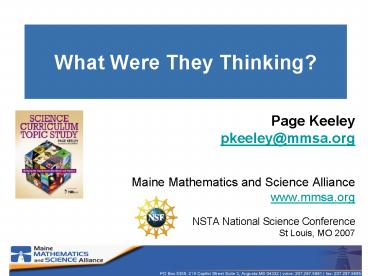What Were They Thinking - PowerPoint PPT Presentation
1 / 13
Title:
What Were They Thinking
Description:
'Students come to the classroom with preconceptions about how the world works. ... Different arrangements of atoms into groups compose all substances. ... – PowerPoint PPT presentation
Number of Views:28
Avg rating:3.0/5.0
Title: What Were They Thinking
1
What Were They Thinking?
- Page Keeley
- pkeeley_at_mmsa.org
- Maine Mathematics and Science Alliance
- www.mmsa.org
- NSTA National Science Conference
- St Louis, MO 2007
2
Key Finding from How People Learn
Students come to the classroom with
preconceptions about how the world works. If
their initial understanding is not engaged, they
may fail to grasp the new concepts and
information that are taught, or they may learn
them for purposes of a test but revert to their
preconceptions outside the classroom How People
Learn, Bransford, Brown Cockling. pp 14-15
3
Assessment Probes
- A probe is a purposefully designed question that
links standards-based ideas with research on
students conceptions. - A probe reveals more than just an answer.
- A probe elicits a response that helps teachers
identify students ideas about a phenomenon or a
concept.
4
(No Transcript)
5
Related Learning Goals in the Benchmarks for
Science Literacy
- K-2 The Earth Water can be a liquid or a solid
and can go back and forth from one form to the
other. If water is turned into ice and then the
ice is allowed to melt, the amount of water is
the same as it was before freezing. - 3-5 Structure of Matter No matter how parts of
an object are assembled, the weight of the whole
object made is always the same as the sum of the
parts and when a thing is broken into parts, the
parts have the same total weight as the original
thing. - 6-8 Structure of Matter No matter how
substances within a closed system interact with
one another, or how they combine or break apart,
the total weight of the system remains the same.
The idea of atoms explains the conservation of
matter If the number of atoms stays the same no
matter how they are rearranged then the mass
stays the same. - .
6
Research on Learning
- Students need to have a concept of matter in
order to understand conservation of matter. (BSL
p 336) - Confusion between weight and density contributes
to difficulty understanding conservation of
matter. (BSL p 336) - Some students believe one state of matter of the
same substance has more or less weight than a
different state. (Driver et al., p 80) - The way a student perceives a chemical or
physical change may determine whether they
understand matter is conserved. For example, if
it looks as if something has disappeared or
spread out more, then student may think the mass
changes. (Driver et al. p 77)
7
(No Transcript)
8
Lemonade
- There is often a discrepancy between weight and
matter conservation with dissolving. Some
students accept the idea that the substance is
still there but the weight is negligible, is up
in the water, or it no longer weighs anything.
(Driver et al., p 84)
9
Chemical Bonds
- 6-8 Benchmark All matter is made up of atoms,
which are far too small to see directly through a
microscope. The atoms of any element are alike
but are different from atoms of other elements.
Atoms may stick together in well-defined
molecules or may be packed together in large
arrays. Different arrangements of atoms into
groups compose all substances. - 9-12 Benchmark Atoms are made of a positive
nucleus surrounded by negative electrons. An
atom's electron configuration, particularly the
outermost electrons, determines how the atom can
interact with other atoms. Atoms form bonds to
other atoms by transferring or sharing electrons.
10
Characteristic Properties
- Density
- Boiling Point
- Freezing Point
11
(No Transcript)
12
(No Transcript)
13
(No Transcript)































